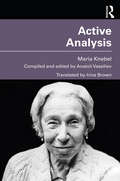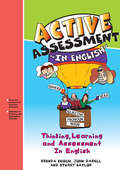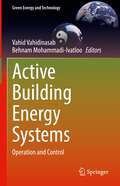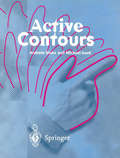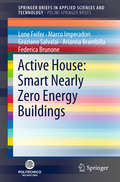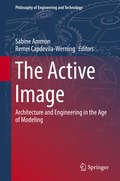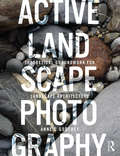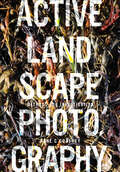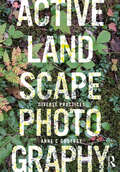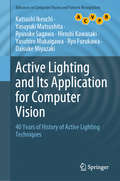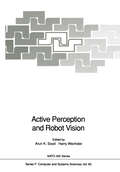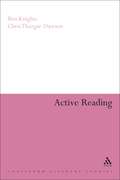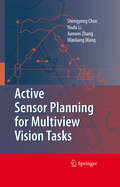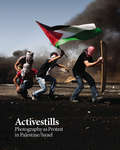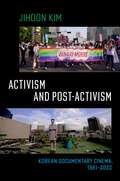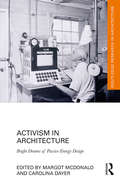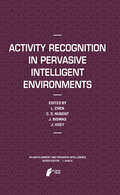- Table View
- List View
Active Analysis
by Maria KnebelActive Analysis combines two of Maria Knebel’s most important books, On Active Analysis of the Play and the Role and The Word in the Actor’s Creative Work, in a single edition conceived and edited by one of Knebel's most famous students, the renowned theatre and film director, Anatoli Vassiliev. This is the first English translation of an important and authoritative fragment of the great Stanislavski jigsaw. A landmark publication. This book is an indispensable resource for professional directors, student directors, actors and researchers interested in Stanislavski, directing, rehearsal methods and theatre studies more generally.
Active Analysis
by Maria KnebelActive Analysis combines two of Maria Knebel’s most important books, On Active Analysis of the Play and the Role and The Word in the Actor’s Creative Work, in a single edition conceived and edited by one of Knebel's most famous students, the renowned theatre and film director, Anatoli Vassiliev. This is the first English translation of an important and authoritative fragment of the great Stanislavski jigsaw. A landmark publication. This book is an indispensable resource for professional directors, student directors, actors and researchers interested in Stanislavski, directing, rehearsal methods and theatre studies more generally.
Active Assessment in English: Thinking Learning and Assessment In English
by Brenda Keogh John Dabell Stuart NaylorEverybody seems to be talking about Assessment for Learning. This book shows you how to do it.The thinking behind the highly influential ‘Assessment for Learning’ approach is translated into usable and practical strategies for all those teaching literacy in primary and secondary classrooms.The authors show how thinking, learning and assessment can be linked together in a creative and integrated fashion, so that thinking promotes learning, learning enables assessment to take place and assessment acts as a stimulus to both thinking and learning. Concise teachers’ notes for a broad range of dynamic techniques explain for each:what the approach ishow you use it for assessment how you can manage it in the classroomhow it helps with learning.Downloadable resources are included with all of the activities and ideas that can be used on Interactive Whiteboards. Active Assessment for English will prove inspiring reading for all literacy teachers at primary and secondary levels, LEA advisers and inspectors.
Active Assessment in English: Thinking Learning and Assessment In English
by Brenda Keogh John Dabell Stuart NaylorEverybody seems to be talking about Assessment for Learning. This book shows you how to do it.The thinking behind the highly influential ‘Assessment for Learning’ approach is translated into usable and practical strategies for all those teaching literacy in primary and secondary classrooms.The authors show how thinking, learning and assessment can be linked together in a creative and integrated fashion, so that thinking promotes learning, learning enables assessment to take place and assessment acts as a stimulus to both thinking and learning. Concise teachers’ notes for a broad range of dynamic techniques explain for each:what the approach ishow you use it for assessment how you can manage it in the classroomhow it helps with learning.Downloadable resources are included with all of the activities and ideas that can be used on Interactive Whiteboards. Active Assessment for English will prove inspiring reading for all literacy teachers at primary and secondary levels, LEA advisers and inspectors.
Active Building Energy Systems: Operation and Control (Green Energy and Technology)
by Behnam Mohammadi-Ivatloo Vahid VahidinasabThis book provides a comprehensive study on state-of-the-art developments in the control, operation, and market participation of active buildings (ABs). Active buildings can support the broader energy system by intelligent integration of renewable-based energy technologies for heating, cooling, electricity, and transport. This important reference analyzes the key features of modern control and operation techniques applied to these systems. Contributions from an international team of experts present practical methods with evidence and case studies from applications to real-world or simulated active buildings. Sample computer codes and analytical examples aid in the understanding of the presented methods. The book will support researchers working on the control and operation of buildings as an energy system, smart cities and smart grids, and microgrids, as well as researchers and developers from the building and energy engineering, economic, and operation research fields.Provides an in-depth review of building-level energy systems technologies;Covers codes, standards, and requirements for active building control systems;Includes sample computer code and analytical examples.
Active Contours: The Application of Techniques from Graphics, Vision, Control Theory and Statistics to Visual Tracking of Shapes in Motion
by Andrew Blake Michael IsardActive Contours deals with the analysis of moving images - a topic of growing importance within the computer graphics industry. In particular it is concerned with understanding, specifying and learning prior models of varying strength and applying them to dynamic contours. Its aim is to develop and analyse these modelling tools in depth and within a consistent framework.
Active House: Smart Nearly Zero Energy Buildings (SpringerBriefs in Applied Sciences and Technology)
by Lone Feifer Marco Imperadori Graziano Salvalai Arianna Brambilla Federica BrunoneThe book provides an overview of the Active House (AH) vision, intended as a building design method “beyond” the passive approach for buildings of the future that will be more and more connected, smart and innovative. It offers a novel philosophical design approach in which buildings, new or renovated, are in balance with natural, renewable energies and become “concentrators-distributors” of energies instead of being consumers of resources. The book is composed of five chapters, providing information on fundamental aspects of innovations toward resource-efficient buildings, as well as case studies presenting the concept in practice. It demonstrates that a completely new design approach is possible, and that a turning point has been reached. Lastly, it shows how the AH Alliance, along with designers, institutions, industries and academies, is bringing a breath of fresh air to the world of construction.
The Active Image: Architecture and Engineering in the Age of Modeling (Philosophy of Engineering and Technology #28)
by Sabine Ammon Remei Capdevila-WerningThe “active image” refers to the operative nature of images, thus capturing the vast array of “actions” that images perform. This volume features essays that present a new approach to image theory. It explores the many ways images become active in architecture and engineering design processes and how, in the age of computer-based modeling, images play an indispensable role.The contributors examine different types of images, be they pictures, sketches, renderings, maps, plans, and photographs; be they analog or digital, planar or three-dimensional, ephemeral, realistic or imaginary. Their essays investigate how images serve as means of representing, as tools for thinking and reasoning, as ways of imagining the inexistent, as means of communicating and conveying information and how images may also perform functions and have an agency in their own.The essays discuss the role of images from the perspective of philosophy, theory and history of architecture, history of science, media theory, cognitive sciences, design studies, and visual studies, offering a multidisciplinary approach to imagery and showing the various methodologies and interpretations in current research. In addition, they offer valuable insight to better understand how images operate and function in the arts and sciences in general.
Active Landscape Photography: Theoretical Groundwork for Landscape Architecture
by Anne C GodfreyPhotographs play a hugely influential but largely unexamined role in the practice of landscape architecture and design. Through a diverse set of essays and case studies, this seminal text unpacks the complex relationship between landscape architecture and photography. It explores the influence of photographic seeing on the design process by presenting theoretical concepts from photography and cultural theory through the lens of landscape architecture practice to create a rigorous, open discussion. Beautifully illustrated in full color throughout, with over 200 images, subjects covered include the diversity of everyday photographic practices for design decision making, the perception of landscape architecture through photography, transcending the objective and subjective with photography, and deploying multiplicity in photographic representation as a means to better represent the complexity of the discipline. Rather than solving problems and providing tidy solutions to the ubiquitous relationship between photography and landscape architecture, this book aims to invigorate a wider dialogue about photography's influence on how landscapes are understood, valued and designed. Active photographic practices are presented throughout for professionals, academics, students and researchers.
Active Landscape Photography: Theoretical Groundwork for Landscape Architecture
by Anne C GodfreyPhotographs play a hugely influential but largely unexamined role in the practice of landscape architecture and design. Through a diverse set of essays and case studies, this seminal text unpacks the complex relationship between landscape architecture and photography. It explores the influence of photographic seeing on the design process by presenting theoretical concepts from photography and cultural theory through the lens of landscape architecture practice to create a rigorous, open discussion. Beautifully illustrated in full color throughout, with over 200 images, subjects covered include the diversity of everyday photographic practices for design decision making, the perception of landscape architecture through photography, transcending the objective and subjective with photography, and deploying multiplicity in photographic representation as a means to better represent the complexity of the discipline. Rather than solving problems and providing tidy solutions to the ubiquitous relationship between photography and landscape architecture, this book aims to invigorate a wider dialogue about photography's influence on how landscapes are understood, valued and designed. Active photographic practices are presented throughout for professionals, academics, students and researchers.
Active Landscape Photography: Methods for Investigation (Active Landscape Photography)
by Anne C GodfreyHow can photography be transformed into an active process of investigation for landscape architecture and environmental design? The second book in Godfrey’s series, Active Landscape Photography, presents engaged photographic methods that turn photography into a rigorous, thoughtful endeavor for the research, planning and design of landscape places. Photography is the most ubiquitous and important form of representation in these disciplines. Yet photography is not specifically taught as a core skill within these fields. This book creates a starting point for filling this gap. Concepts and working methods from contemporary photography and critical cultural theories are contextualized into situations encountered in the daily practice of landscape architecture and environmental design. These methods can be integrated into practices in academic and professional settings or picked up and self-taught by an individual reader. Part I: Methods presents easily accessible approaches to photography creating a core set of active skills. Part II: Practices discusses working methods of specific contemporary photographers and extrapolates their practices into common extrapolates their practices into common planning and design situations. Contemporary photographers presented include Richard Misrach, Dawoud Bey, Duane Michals, Latoya Ruby Frazier, Mark Klett, Sophie Calle, Joe Deal, Robert Adams, Naima Green, Bernd and Hilla Becher, Stephen Shore, David Hockney, Amy Sherald, William Christenberry, Jeff Wall, and Sohei Nishino. Beautifully illustrated in full color with over 150 images by Godfrey, her students, and contemporary photographers, this book provides both clear guidelines for a set of diverse methods as well as a deeper discussion about the implications of making and using photography in environmental design for professionals, academics, students and researchers.
Active Landscape Photography: Methods for Investigation (Active Landscape Photography)
by Anne C GodfreyHow can photography be transformed into an active process of investigation for landscape architecture and environmental design? The second book in Godfrey’s series, Active Landscape Photography, presents engaged photographic methods that turn photography into a rigorous, thoughtful endeavor for the research, planning and design of landscape places. Photography is the most ubiquitous and important form of representation in these disciplines. Yet photography is not specifically taught as a core skill within these fields. This book creates a starting point for filling this gap. Concepts and working methods from contemporary photography and critical cultural theories are contextualized into situations encountered in the daily practice of landscape architecture and environmental design. These methods can be integrated into practices in academic and professional settings or picked up and self-taught by an individual reader. Part I: Methods presents easily accessible approaches to photography creating a core set of active skills. Part II: Practices discusses working methods of specific contemporary photographers and extrapolates their practices into common extrapolates their practices into common planning and design situations. Contemporary photographers presented include Richard Misrach, Dawoud Bey, Duane Michals, Latoya Ruby Frazier, Mark Klett, Sophie Calle, Joe Deal, Robert Adams, Naima Green, Bernd and Hilla Becher, Stephen Shore, David Hockney, Amy Sherald, William Christenberry, Jeff Wall, and Sohei Nishino. Beautifully illustrated in full color with over 150 images by Godfrey, her students, and contemporary photographers, this book provides both clear guidelines for a set of diverse methods as well as a deeper discussion about the implications of making and using photography in environmental design for professionals, academics, students and researchers.
Active Landscape Photography: Diverse Practices (Active Landscape Photography)
by Anne C GodfreyDiverse Practices, the third book in the Active Landscape Photography series, presents a set of unique photographic examples for site-specific investigations of landscape places. Contributed by authors across academia, practice and photography, each chapter serves as a rigorous discussion about photographic methods for the landscape and their underlying concepts. Chapters also serve as unique case studies about specific projects, places and landscape issues. Project sites include the Miller Garden, Olana, XX Miller Prize and the Philando Castile Peace Garden. Landscape places discussed include the archeological landscapes of North Peru, watery littoral zones, the remote White Pass in Alaska, Sau Paulo and New York City’s Chinatown. Photographic image-making approaches include the use of lidar, repeat photography, collage, mapping, remote image capture, portraiture, image mining of internet sources, visual impact assessment, cameraless photography, transect walking and interviewing. These diverse practices demonstrate how photography, when utilized through a set of specific critical methods, becomes a rich process for investigating the landscape. Exploring this concept in relationship to specific contemporary sties and landscape issues reveals the intricacy and subtlety that exists when photography is used actively. Practitioners, academics, students and researchers will be inspired by the underlying concepts of these examples and come away with a better understanding about how to create their own rigorous photographic practices.
Active Landscape Photography: Diverse Practices (Active Landscape Photography)
Diverse Practices, the third book in the Active Landscape Photography series, presents a set of unique photographic examples for site-specific investigations of landscape places. Contributed by authors across academia, practice and photography, each chapter serves as a rigorous discussion about photographic methods for the landscape and their underlying concepts. Chapters also serve as unique case studies about specific projects, places and landscape issues. Project sites include the Miller Garden, Olana, XX Miller Prize and the Philando Castile Peace Garden. Landscape places discussed include the archeological landscapes of North Peru, watery littoral zones, the remote White Pass in Alaska, Sau Paulo and New York City’s Chinatown. Photographic image-making approaches include the use of lidar, repeat photography, collage, mapping, remote image capture, portraiture, image mining of internet sources, visual impact assessment, cameraless photography, transect walking and interviewing. These diverse practices demonstrate how photography, when utilized through a set of specific critical methods, becomes a rich process for investigating the landscape. Exploring this concept in relationship to specific contemporary sties and landscape issues reveals the intricacy and subtlety that exists when photography is used actively. Practitioners, academics, students and researchers will be inspired by the underlying concepts of these examples and come away with a better understanding about how to create their own rigorous photographic practices.
Active Lighting and Its Application for Computer Vision: 40 Years of History of Active Lighting Techniques (Advances in Computer Vision and Pattern Recognition)
by Katsushi Ikeuchi Yasuyuki Matsushita Ryusuke Sagawa Hiroshi Kawasaki Yasuhiro Mukaigawa Ryo Furukawa Daisuke MiyazakiThis book describes active illumination techniques in computer vision. We can classify computer vision techniques into two classes: passive and active techniques. Passive techniques observe the scene statically and analyse it as is. Active techniques give the scene some actions and try to facilitate the analysis. In particular, active illumination techniques project specific light, for which the characteristics are known beforehand, to a target scene to enable stable and accurate analysis of the scene. Traditional passive techniques have a fundamental limitation. The external world surrounding us is three-dimensional; the image projected on a retina or an imaging device is two-dimensional. That is, reduction of one dimension has occurred. Active illumination techniques compensate for the dimensional reduction by actively controlling the illumination. The demand for reliable vision sensors is rapidly increasing in many application areas, such as robotics and medical image analysis. This book explains this new endeavour to explore the augmentation of reduced dimensions in computer vision. This book consists of three parts: basic concepts, techniques, and applications. The first part explains the basic concepts for understanding active illumination techniques. In particular, the basic concepts of optics are explained so that researchers and engineers outside the field can understand the later chapters. The second part explains currently available active illumination techniques, covering many techniques developed by the authors. The final part shows how such active illumination techniques can be applied to various domains, describing the issue to be overcome by active illumination techniques and the advantages of using these techniques. This book is primarily aimed at 4th year undergraduate and 1st year graduate students, and will also help engineers from fields beyond computer vision to use active illumination techniques. Additionally, the book is suitable as course material for technical seminars.
Active Perception and Robot Vision (NATO ASI Subseries F: #83)
by Arun K. Sood Harry WechslerIntelligent robotics has become the focus of extensive research activity. This effort has been motivated by the wide variety of applications that can benefit from the developments. These applications often involve mobile robots, multiple robots working and interacting in the same work area, and operations in hazardous environments like nuclear power plants. Applications in the consumer and service sectors are also attracting interest. These applications have highlighted the importance of performance, safety, reliability, and fault tolerance. This volume is a selection of papers from a NATO Advanced Study Institute held in July 1989 with a focus on active perception and robot vision. The papers deal with such issues as motion understanding, 3-D data analysis, error minimization, object and environment modeling, object detection and recognition, parallel and real-time vision, and data fusion. The paradigm underlying the papers is that robotic systems require repeated and hierarchical application of the perception-planning-action cycle. The primary focus of the papers is the perception part of the cycle. Issues related to complete implementations are also discussed.
Active Reading: Transformative Writing in Literary Studies (Continuum Literary Studies)
by Ben Knights Chris Thurgar-DawsonThe subject of this book is the crossover between critical study and creative writing. 'Active reading' is a structured process of writing activities using imitation, variation and experimentation. Through practical composition techniques such as 'transformational writing', 're-writing' or 'translation', students can use writing activities to develop their critical imagination. This book bridges the gap between theories of learning and Literary studies in Higher Education. Setting the argument in an historical and theoretical context, it outlines the importance of writing as a medium of learning and argues for its usefulness in aiding English students' understanding of theoretical as well as literary and cultural texts. The authors provide a reflective account of teaching and assessment methods using writing activities and critical thinking techniques and the forms of learning they promote. In the last section, they explore the connections with other forms of writing practice in related disciplines and argue for the role of transformational writing in promoting independent learning. Appendices provide examples of the range of activities that can be used and an indicative list of literary examples.
Active Reading: Transformative Writing in Literary Studies (Continuum Literary Studies)
by Ben Knights Chris Thurgar-DawsonThe subject of this book is the crossover between critical study and creative writing. 'Active reading' is a structured process of writing activities using imitation, variation and experimentation. Through practical composition techniques such as 'transformational writing', 're-writing' or 'translation', students can use writing activities to develop their critical imagination. This book bridges the gap between theories of learning and Literary studies in Higher Education. Setting the argument in an historical and theoretical context, it outlines the importance of writing as a medium of learning and argues for its usefulness in aiding English students' understanding of theoretical as well as literary and cultural texts. The authors provide a reflective account of teaching and assessment methods using writing activities and critical thinking techniques and the forms of learning they promote. In the last section, they explore the connections with other forms of writing practice in related disciplines and argue for the role of transformational writing in promoting independent learning. Appendices provide examples of the range of activities that can be used and an indicative list of literary examples.
Active Sensor Planning for Multiview Vision Tasks
by Shengyong Chen Y. F. Li Jianwei Zhang Wanliang WangThis unique book explores the important issues in studying for active visual perception. The book’s eleven chapters draw on recent important work in robot vision over ten years, particularly in the use of new concepts. Implementation examples are provided with theoretical methods for testing in a real robot system. With these optimal sensor planning strategies, this book will give the robot vision system the adaptability needed in many practical applications.
Activestills: Photography as Protest in Palestine/Israel
by Vered Maimon Shiraz GrinbaumIn 2005, a group of photographers took a stand alongside the people of the small town of Bil’in, and documented their fight to stop the Israeli government building the infamous West Bank Barrier. Inspired by what they had seen in Bil’in, the group went on to form Activestills, a collective whose work has become vital in documenting the struggle against Israeli occupation and everyday life in extraordinary situations. *BR**BR*Activestills: Photography as Protest in Palestine/Israel examines the collective’s archive and activity from historical, theoretical, critical, and personal perspectives. It is the result of an in-depth dialogue among members of the collective and activists, journalists, intellectuals, and academics, and stands as the definitive study of the collective’s work.*BR**BR*Combining striking full-colour photographs with essays and commentary, Activestills stands as both a major contribution to reportage on Israel/Palestine and a unique collection of visual art.
Activism and Post-activism: Korean Documentary Cinema, 1981--2022
by Jihoon KimActivism and Post-activism: Korean Documentary Cinema, 1981--2022 is a new book about nonfiction filmmaking in the private and independent sectors of South Korean cinema and media from the early 1980s to the present day. Drawing on the methodologies of documentary studies, experimental film and video, digital cinema, local discourses on independent documentary, and the literature on the social changes of South Korea, author Jihoon Kim historicizes the formation and development of Korean independent documentary in close dialogue with South Korea's social movements. From the 1980s mass anti-dictatorship movement to twenty-first-century labor issues, feminism, LGBT rights, environmental justice, and key events such as the Sewol Ferry disaster and the Candlelight Protests, Kim offers a comprehensive history of Korean social change documentaries in terms of their activist tradition. At the same time, Kim also maps out the formal and aesthetic divergences of twenty-first-century Korean documentary cinema beyond the activist tradition, while also demonstrating how they have inherited and dynamically renewed the tradition's engagement with contested reality and history. Making the tripartite connections between the socio-political history of South Korea, documentary's aesthetics and politics, and the shifting institutional and technological evolution of documentary production and distribution, the book argues that what is unique about this forty-year history of South Korean documentary cinema is the intensive and compressed coevolution of its two interlocked tendencies: activism and post-activism.
Activism and Post-activism: Korean Documentary Cinema, 1981--2022
by Jihoon KimActivism and Post-activism: Korean Documentary Cinema, 1981--2022 is a new book about nonfiction filmmaking in the private and independent sectors of South Korean cinema and media from the early 1980s to the present day. Drawing on the methodologies of documentary studies, experimental film and video, digital cinema, local discourses on independent documentary, and the literature on the social changes of South Korea, author Jihoon Kim historicizes the formation and development of Korean independent documentary in close dialogue with South Korea's social movements. From the 1980s mass anti-dictatorship movement to twenty-first-century labor issues, feminism, LGBT rights, environmental justice, and key events such as the Sewol Ferry disaster and the Candlelight Protests, Kim offers a comprehensive history of Korean social change documentaries in terms of their activist tradition. At the same time, Kim also maps out the formal and aesthetic divergences of twenty-first-century Korean documentary cinema beyond the activist tradition, while also demonstrating how they have inherited and dynamically renewed the tradition's engagement with contested reality and history. Making the tripartite connections between the socio-political history of South Korea, documentary's aesthetics and politics, and the shifting institutional and technological evolution of documentary production and distribution, the book argues that what is unique about this forty-year history of South Korean documentary cinema is the intensive and compressed coevolution of its two interlocked tendencies: activism and post-activism.
Activism in Architecture: Bright Dreams of Passive Energy Design (Routledge Research in Architecture)
by Margot McDonald Carolina DayerThis edited collection gathers contributions from a diverse range of renowned scholars and professionals to uncover the unique relationship between passive architectural systems and activism. Focusing on the pioneering work of the influential American chemist and inventor, Harold R. Hay (1909–2009), and the environmental awareness events that took hold in the United States during the 1960s and 1970s, the book assembles essays which closely examine Hay's contribution to architecture and the work of those who directly and tangentially were affected by it. The book also offers insights into the role of passive energy design today. Appealing to researchers, architects and students interested in architecture and design technology, Activism in Architecture explores the role of passive environmental inventions as an active agent in shaping socio-political debates.
Activism in Architecture: Bright Dreams of Passive Energy Design (Routledge Research in Architecture)
This edited collection gathers contributions from a diverse range of renowned scholars and professionals to uncover the unique relationship between passive architectural systems and activism. Focusing on the pioneering work of the influential American chemist and inventor, Harold R. Hay (1909–2009), and the environmental awareness events that took hold in the United States during the 1960s and 1970s, the book assembles essays which closely examine Hay's contribution to architecture and the work of those who directly and tangentially were affected by it. The book also offers insights into the role of passive energy design today. Appealing to researchers, architects and students interested in architecture and design technology, Activism in Architecture explores the role of passive environmental inventions as an active agent in shaping socio-political debates.
Activity Recognition in Pervasive Intelligent Environments (Atlantis Ambient and Pervasive Intelligence #4)
by Liming Chen Chris D. Nugent Jit Biswas Jesse HoeyThis book consists of a number of chapters addressing different aspects of activity recognition, roughly in three main categories of topics. The first topic will be focused on activity modeling, representation and reasoning using mathematical models, knowledge representation formalisms and AI techniques. The second topic will concentrate on activity recognition methods and algorithms. Apart from traditional methods based on data mining and machine learning, we are particularly interested in novel approaches, such as the ontology-based approach, that facilitate data integration, sharing and automatic/automated processing. In the third topic we intend to cover novel architectures and frameworks for activity recognition, which are scalable and applicable to large scale distributed dynamic environments. In addition, this topic will also include the underpinning technological infrastructure, i.e. tools and APIs, that supports function/capability sharing and reuse, and rapid development and deployment of technological solutions. The fourth category of topic will be dedicated to representative applications of activity recognition in intelligent environments, which address the life cycle of activity recognition and their use for novel functions of the end-user systems with comprehensive implementation, prototyping and evaluation. This will include a wide range of application scenarios, such as smart homes, intelligent conference venues and cars.
